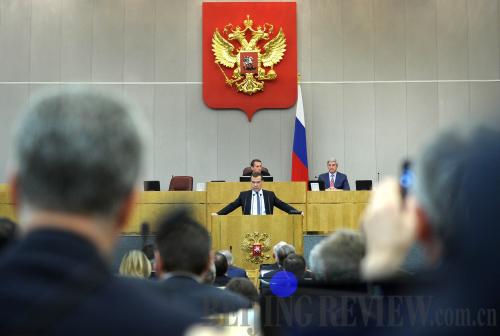|
 |
|
SUPPORT FROM THE TOP: Prime Minister Dmitry Medvedev pledges to boost the development of Russia's Far East at the lower house of the Russian parliament in Moscow on April 17, 2013 (XINHUA/AFP) |

Since Vladimir Putin assumed Russia's presidency again in 2012, the development of the country's eastern region has become a national strategic priority. The policy shift has not only brought new opportunities for the economic growth and urban development of Russia's eastern part but also provided much more room for regional cooperation between China and Russia.
Tremendous potential
The eastern part of Russia mainly refers to the country's Siberian Federal District and Far East Federal District. Given natural geographical factors, regional development history and national policies, the prospects for urban development in the eastern region are promising.
The economic and social development of Russia is spatially imbalanced. Gaps of development between cities are quite large. The western region of Russia makes up about 78 percent of the country's total population, while producing more than 70 percent of its total industrial products and 76 percent of its total agricultural products. The population density of Russia's eastern region is only one 11th that of the western region. Thus, the urban development potential in the eastern region is tremendous.
Most of Russia's mineral, energy, forest, water and marine biological resources are concentrated in the eastern region. Therefore, the eastern region plays a decisive role in Russia's raw material supply and energy security.
Currently, as the western region of Russia becomes increasingly scarce in resources, the country's economic development is more and more dependent on the resources of its eastern region. With intensified instability in the Middle East, eastern Russia's energy exporter status in the world market will be further enhanced. In the next 20 or 30 years, both the domestic and global demand for economic development will further promote the resource development of Russia's eastern region, which could exert a great influence on urban development in the region.
After the disintegration of the Soviet Union, the eastern region of Russia began to lose the Central Government's policy and financial support for development due to the ending of the Soviet Union's strategy of balancing regional development. The economic situation in the region continued to deteriorate as the development gap between the east and the west increased sharply. The Federal Government of Russia is aware that the economic backwardness of the eastern region not only hinders its involvement in Asia-Pacific economic cooperation, but also restricts the revival of the national economy. Therefore, Russia has begun to gradually adjust its national development strategy, with federal policies tilted in favor of the eastern region.
A more reasonable layout
Under the market mechanism, economic ties between cities will be further strengthened. Population, resources and economic activities within the region are likely to further agglomerate to major cities with greater potential for development and economic benefits. Most of the big cities today are likely to become cornerstones in the new regional economic system.
The eastern region is Russia's most important raw mineral base, containing more than 80 percent of the proven deposits of the country's mineral resources. These resources have not yet been mined en masse, however. The future development prospects are beyond measure. With the deepening of exploration and infrastructure improvement, it is certainly possible that new sources of economic growth will emerge in areas with abundant resource reserves, giving rise to new resource-based cities.
| 